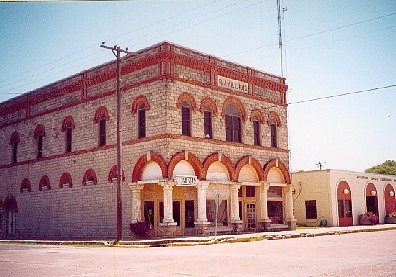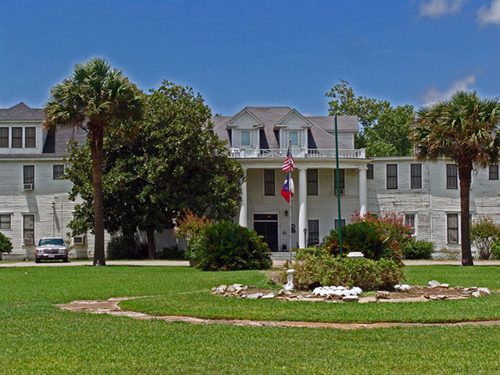|
|
Tres Palacios
River
Photo courtesy Ken
Rudine, July 2008
|
History in
a Pecan Shell
The
name: Trespalacios is Spanish for Three Palaces. The town was
named after the bay and the bay was named after a mirage supposedly
seen by shipwrecked Spanish sailors. They imagined seeing three palaces
on shore which disappeared as they approached. It's a much more colorful
story than simply admitting that it was simply named after Jose Felix
Trespalacios. Somewhere along the way (around 1902) two palaces were
lost and the town is now simply Palacios.
Bill and Clare Bradfield, authors of Texas Towns from A to Z Pronunciation
Guide, (Three Forks Press 1996) remind us that Palacios is pronounced
Puh-LASH-uhs and not the proper Spanish Pa-las-ee-ohs).
Cattle baron Shanghai
Pierce had originally owned the land where Palacios is today.
If he hadn't sold it - you can bet his statue (now in a cemetery near
Blessing) would be in the most
obvious spot in Palacios. Pierce was a modest man who ordered his
statue carved before he died so he'd have time to admire it.
In 1901 the land was bought from Pierce
by The Texas Rice Development Company. They in turn sold the townsite
to their own subsidiary - The Palacios City Townsite Company. This
is when the change from Trespalacios to Palacios was
made (1902).
1903 brought a hotel, the railroad and a post office. The next year
a pavilion was built and the oyster and seafood industry started.
|
 |
The 1910 R. J.
Hill Building
Recorded Texas Historic Landmark
TE photo, 2001 |
|
R. J. Hill Building
Historical Marker
Photo courtesy Ken
Rudine, July 2008
|
A breeze-shaped
tree on the Bay.
TE photo, 2001 |
Texas granite
from Marble
Falls forms a jetty
TE photo, 2001 |
Tres Palacios
River Bridge
TE photo,
June 2001 |
PALACIOS
by Mike Cox (From "Texas Tales" column)
Palacios has had a post office since 1903, but people had been trying
to build a city on the upper end of Matagorda Bay long before then.
Had the first effort been successful, it would have changed the map
of Texas – at least some of the words on that map. In 1836, Capt.
Thomas Bridges, a shipmate from Boston, acquired title to 800 acres
on Oliver Point, not far from present Palacios.
Bridges had a substantial town site surveyed and soon traveled to
New York City to sell lots. He envisioned his town in the new Republic
of Texas as a major port, even thought his land lay 17 miles from
the open Gulf of Mexico. Such an important future metropolis, he reasoned,
needed an equally important name.
The new town, soon to be a prosperous city, would honor the man considered
the Father of Texas, Stephen Fuller Austin.
Unfortunately, the first Austin, Texas fell far short of greatness.
Today, few people even know Texas had another Austin before the Colorado
River village of Waterloo acquired the name in 1839 when a presidential
commission located the capital there.
Meanwhile, back in Matagorda County ... Read
full article › |
 |
|
Palacios Downtown
Photo courtesy Ken
Rudine, July 2008
|
|
City of Palacios
sign
Photo courtesy Ken
Rudine, July 2008
|
|
|
|
A
pavilion on the Bay,
now demolished
TE photo, 2001 |
Shrimp
boats in drydock
TE photo, 2001 |
TE
photo, 1998
|
|
Palacios
acquired a caboose with an appropriate bay window. This has to be
purely coincidental since the city couldn't possibly predict which
type would be available at the caboose auction.
TE
photo, 2001
|
Palacios,
Texas Nearby Destinations
Texas
Gulf Coast
Matagorda County
West - Port
Alto, Olivia, Point
Comfort, Port Lavaca,
Victoria, Indianola,
Port O'Connor
East - Collegeport,
Matagorda
North - Blessing,
Danevang, El
Campo
Book Hotel Here:
Bay City Hotels
| Port
Lavaca Hotels | More
Hotels
|
| Texas
Escapes, in its purpose to preserve historic, endangered and vanishing
Texas, asks that anyone wishing to share their local history, stories,
landmarks and recent or vintage photos, please contact
us. |
|
|

 Texas
Gulf Coast
Texas
Gulf Coast East
Texas
East
Texas Central
Texas North
Central
Texas North Central
Texas South
Central
Texas South Texas
Panhandle
Texas
Panhandle South
Texas
South
Texas Texas
Hill Country
Texas
Hill Country West
Texas
West
Texas Texas
Ghost Towns
Texas
Ghost Towns Texas
Counties
Texas
Counties